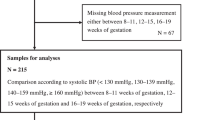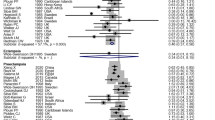Abstract
This prospective observational study aimed to identify at presentation the maternal hemodynamic and demographic variables associated with a therapeutic response to oral labetalol and to use these variables to develop a prediction model to anticipate the response to labetalol monotherapy in women with hypertension. It was set at a maternity unit in a UK teaching hospital. Maternal demographic data from 50 pregnant women, presenting with hypertension between January and August 2013, was collected and blood pressure measured with a device validated for pregnancy and pre-eclampsia. Maternal haemodynamics were assessed with a bioreactance monitor. Participants were commenced on oral labetalol, and reviewed until delivery and discharge home. Logistic regression analysis was performed to assess the prediction of response to labetalol according to the maternal demographic and hemodynamic variables. Main outcome measures were the response to labetalol monotherapy up to delivery and discharge home, defined as sustained blood pressure control <140/90, and the rates of severe hypertension. Thirty-seven women (74%) had their blood pressure well controlled with labetalol monotherapy, 13 (26%) failed to achieve control with labetalol alone, of whom 9 developed severe hypertension. Multivariate logistic regression showed that heart rate, ethnicity and stroke volume index were independent predictors of the response to labetalol. The predictive accuracy of the model was 96% (95% confidence interval (CI) 86–99%). Maternal demographics and haemodynamics are potent predictors for the response to labetalol, and these parameters may guide therapy to enable effective blood pressure control and a lowering of severe hypertension rates.
This is a preview of subscription content, access via your institution
Access options
Subscribe to this journal
Receive 12 digital issues and online access to articles
$119.00 per year
only $9.92 per issue
Buy this article
- Purchase on Springer Link
- Instant access to full article PDF
Prices may be subject to local taxes which are calculated during checkout


Similar content being viewed by others
References
National Institute for Health and Clinical Excellence. Hypertension: the Clinical Management of Primary Hypertension in Adults: update of Clinical Guidelines 18 and 34. Royal College of Physicians: London, 2011.
Blood Pressure Lowering Treatment Trialists' Collaboration. Effects of different blood-pressure-lowering regimens on major cardiovascular events: results of prospectively-designed overviews of randomised trials. The Lancet 2003; 362 (9395): 1527–1535.
Davis B, Cutler JA, Gordon D . Major outcomes in high risk hypertensive patients randomized to angiotensin-converting enzyme inhibitor or calcium channel blocker vs diuretic: the Antihypertensive and Lipid Lowering treatment to prevent Heart Attack Trial (ALLHAT). Jama 2002; 288 (23): 2981–2997.
Brown MJ and Hypertension and ethnic group. BMJ. British Medical Journal. 2006; 332 (7545): 833.
Gupta AK, Poulter NR, Dobson J, Eldridge S, Cappuccio FP, Caulfield M et al. Ethnic differences in blood pressure response to first and second-line antihypertensive therapies in patients randomized in the ASCOT Trial. American journal of hypertension 2010; 23 (9): 1023–1030.
Julius S, Krause L, Schork NJ, Mejia AD, Jones KA, van de Ven C et al. Hyperkinetic borderline hypertension in Tecumseh. Michigan. Journal of hypertension 1991; 9 (1): 77–84.
Schobel HP, Schmieder RE . Haemodynamics in hypertension. Baillière's clinical anaesthesiology 1997; 11 (4): 623–637.
Smith RD, Levy P, Ferrario CM . Value of noninvasive hemodynamics to achieve blood pressure control in hypertensive subjects. Hypertension 2006; 47 (4): 771–777.
Abalos E, Duley L, Steyn DW . Antihypertensive drug therapy for mild to moderate hypertension during pregnancy. Cochrane Database of Systematic Reviews 2014; (2): CD002252.
Magee LA, von Dadelszen P, Rey E, Ross S, Asztalos E, Murphy KE et al. Less-tight versus tight control of hypertension in pregnancy. New England Journal of Medicine. 2015; 372 (5): 407–417.
National Institute for Health and Clinical Excellence. Hypertension in pregnancy: the management of hypertensive disorders during pregnancy. RCOG Press: London, 2011.
Hypertension in pregnancy. Report of the American College of Obstetricians and Gynecologists' Task Force on Hypertension in Pregnancy. Obstet Gynecol. 2013; 122 (5): 1122–1131.
Chung Y, de Greeff A, Shennan A . Validation and compliance of a home monitoring device in pregnancy: microlife WatchBP home. Hypertension in pregnancy 2009; 28 (3): 348–359.
Squara P, Denjean D, Estagnasie P, Brusset A, Dib JC, Dubois C . Noninvasive cardiac output monitoring (NICOM): a clinical validation. Intensive Care Med. 2007; 33 (7): 1191–1194.
Raval NY, Squara P, Cleman M, Yalamanchili K, Winklmaier M, Burkhoff D . Multicenter evaluation of noninvasive cardiac output measurement by bioreactance technique. J Clin Monit Comput 2008; 22 (2): 113–119.
Ohashi Y, Ibrahim H, Furtado L, Carvalho JCA . Non-invasive hemodynamic assessment of non-pregnant, healthy pregnant and preeclamptic women using bio-reactance. Revista brasileira de anestesiologia 2010; 60 (6): 608–613.
Poggio T, Rifkin R, Mukherjee S, Niyogi P . General conditions for predictivity in learning theory. Nature 2004; 428 (6981): 419–422.
Zhou XH, Qin G . Improved confidence intervals for the sensitivity at a fixed level of specificity of a continuous-scale diagnostic test. Stat Med. 2005; 24 (3): 465–477.
Hanley JA, McNeil BJ . The meaning and use of the area under a receiver operating characteristic (ROC) curve. Radiology 1982; 143 (1): 29–36.
Julius S . Transition from high cardiac output to elevated vascular resistance in hypertension. American heart journal 1988; 116 (2): 600–606.
Lund-Johansen P . Hemodynamic patterns in the natural history of borderline hypertension. Journal of cardiovascular pharmacology 1986; 8: S8–S14.
Brown MJ . A rational basis for selection among drugs of the same class. Heart 2003; 89 (6): 687–694.
James PA, Oparil S, Carter BL, Cushman WC, Dennison-Himmelfarb C, Handler J et al. 2014 evidence-based guideline for the management of high blood pressure in adults: report from the panel members appointed to the Eighth Joint National Committee (JNC 8). JAMA 2014; 311 (5): 507–520.
Bosio PM, McKenna PJ, Conroy R, O'HERLIHY C . Maternal central hemodynamics in hypertensive disorders of pregnancy. Obstetrics & Gynecology 1999; 94 (6): 978–984.
Stewart AD, Millasseau SC, Dawes M, Kyd PA, Chambers JB, Ritter JM et al. Aldosterone and left ventricular hypertrophy in Afro-Caribbean subjects with low renin hypertension. American journal of hypertension 2006; 19 (1): 19–24.
Stott D, Bolten M, Paraschiv D, Papastefanou I, Chambers J, Kametas N . Original research article: Maternal ethnicity and its impact on the haemodynamic and blood pressure response to labetalol for the treatment of antenatal hypertension. Open Heart 2016; 3 (1): e000351.
Acknowledgements
The study was partly funded by a grant from The King’s College Hospital Charity (Registered Charity 230729). AD acknowledges financial support from the National Institute for Health Research (NIHR) Biomedical Research and from the NIHR Collaboration for Leadership in Applied Health Research and Care South London at King's College Hospital NHS Foundation Trust.
Author contributions
DS was involved in the planning of the study, collection of data, analysis of the data, and the planning and writing of the manuscript. MB was involved in the collection and analysis of the data, and the preparation of the manuscript. MS was involved in the collection and analysis of the data, and the preparation of the manuscript. DP was involved in the collection and analysis of the data, and the preparation of the manuscript. AD was involved in the planning of the study, the statistical analysis and the preparation of the manuscript. NK was involved in the supervision and planning of the study, analysis of the data, and the planning and writing of the manuscript.
Author information
Authors and Affiliations
Corresponding author
Ethics declarations
Competing interests
The authors declare no conflict of interest.
Rights and permissions
About this article
Cite this article
Stott, D., Bolten, M., Salman, M. et al. A prediction model for the response to oral labetalol for the treatment of antenatal hypertension. J Hum Hypertens 31, 126–131 (2017). https://doi.org/10.1038/jhh.2016.50
Received:
Revised:
Accepted:
Published:
Issue Date:
DOI: https://doi.org/10.1038/jhh.2016.50



